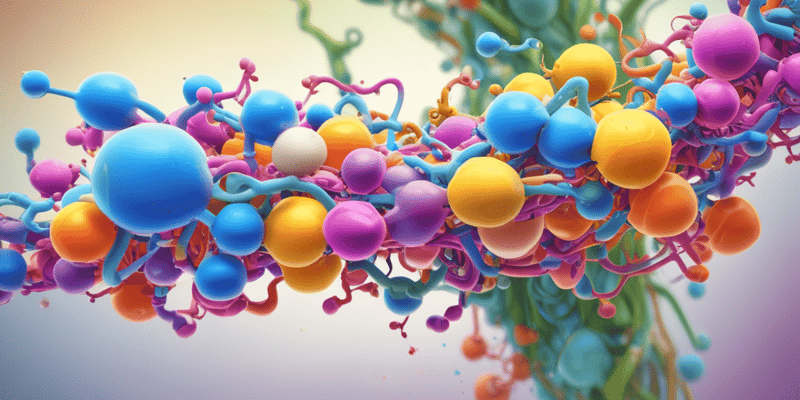30 Questions
What is the primary function of the pentose phosphate pathway?
To synthesize ribose for nucleotide and nucleic acid formation
Which enzyme deficiency can cause acute hemolysis of red blood cells?
Glucose-6-phosphate dehydrogenase (G6PD)
Which of the following metabolic diseases is caused by a deficiency in the uronic acid pathway?
Essential pentosuria
What is the main role of glucuronic acid synthesis in the body?
To facilitate the conjugation and excretion of metabolites and foreign chemicals (xenobiotics)
Which of the following hexoses are the main ones absorbed from the gastrointestinal tract?
Glucose, fructose, and galactose
How does the pentose phosphate pathway differ from glycolysis?
The pentose phosphate pathway is a more complex pathway than glycolysis
What coenzyme is required for the reaction catalyzed by transketolase in the pentose phosphate pathway?
Thiamin diphosphate (vitamin B1)
What type of carbon-sugars are produced by the pentose phosphate pathway?
3 carbon-sugars and 7 carbon-sugars
Which of the following tissues has low activity of the pentose phosphate pathway?
Skeletal muscle
What is the purpose of the pentose phosphate pathway in tissues where it is active?
To provide NADPH for reductive biosynthesis reactions
What enzyme is responsible for the reversal of glycolysis to convert glyceraldehyde-3-phosphate to glucose-6-phosphate in the pentose phosphate pathway?
Fructose 1,6-bisphosphatase
What is the significance of measuring erythrocyte transketolase and its activation by thiamin diphosphate?
It provides an index of vitamin B1 (thiamin) nutritional status.
What is the main mechanism by which fructose consumption leads to increased fatty acid synthesis and secretion of VLDL?
Fructose is phosphorylated by fructokinase, leading to the accumulation of fructose-1-phosphate
How does the metabolism of fructose differ from that of glucose in the liver?
Fructose is metabolized exclusively through glycolysis, while glucose can also undergo gluconeogenesis
What is the fate of the two triose phosphates (dihydroxyacetone phosphate and glyceraldehyde-3-phosphate) produced from the cleavage of fructose-1-phosphate?
They may be degraded through glycolysis or used for gluconeogenesis
Why is fructose metabolism not affected by fasting (glucagon) or insulin in diabetic patients?
Fructose is phosphorylated by hexokinase, which is not regulated by insulin or glucagon
What is the role of aldolase B in the metabolism of fructose?
Aldolase B cleaves fructose-1-phosphate into dihydroxyacetone phosphate and glyceraldehyde
How does the metabolism of fructose contribute to the development of hypertriglyceridemia and hypercholesterolemia?
Fructose metabolism floods the liver with glyceraldehyde-3-phosphate, which is shunted into fatty acid and triglyceride synthesis
What is the consequence of excessive glucose-6-phosphate production in the liver?
Elevated uric acid production
Which enzyme catalyzes the phosphorylation of galactose in the liver?
Galactokinase
What is the fate of much of the fructose metabolized in the liver?
Degraded by gluconeogenesis
What is the end product of the conversion of UDPGal to UDPGlc in the liver?
Glucose
Which condition may result from excessive triglyceride synthesis in the liver?
Hyperuricemia
What is the role of galactose in the body aside from lactose formation during lactation?
Formation of glycolipids and glycoproteins
What is the predominant simple glycosphingolipid found in extra neural tissues?
Glucosylceramide
Which type of glycosphingolipid is derived from glucosylceramide and contains sialic acid?
Gangliosides
What is the principal sialic acid found in human tissues?
Neuraminic acid
In which tissues are gangliosides present in high concentration?
Nervous tissues
Impairment of which pathway leads to erythrocyte hemolysis?
Pentose phosphate pathway
Which enzyme is dependent on a supply of NADPH formed via the pentose phosphate pathway?
Glutathione peroxidase
Study Notes
The Pentose Phosphate Pathway
- Alternative route for glucose metabolism that doesn't produce ATP, but has two major functions: generating NADPH for fatty acid synthesis and maintaining reduced glutathione for antioxidant activity and bilirubin metabolism, and synthesizing ribose for nucleotide and nucleic acid formation.
Hexose Metabolism
- Glucose, fructose, and galactose are main hexoses absorbed from the gastrointestinal tract, derived from dietary starch, sucrose, and lactose.
- Fructose and galactose can be converted to glucose, mainly in the liver.
Genetic Deficiencies
- Genetic deficiency of glucose-6-phosphate dehydrogenase (G6PD) causes acute hemolysis of red blood cells, resulting in hemolytic anemia.
- Deficiencies in the uronic acid pathway lead to essential pentosuria.
- Deficiencies in fructose and galactose metabolism lead to metabolic diseases such as essential fructosuria, hereditary fructose intolerance, and galactosemia.
The Pentose Phosphate Pathway Mechanism
- Requires Mg2+ and thiamin diphosphate (vitamin B1) as coenzyme.
- Involves the reversal of glycolysis and the gluconeogenic enzyme fructose 1,6-bisphosphatase in tissues that contain this enzyme (liver, kidney, and intestines).
- Active in liver, adipose tissue, adrenal cortex, thyroid, erythrocytes, testis, and lactating mammary gland.
- Low activity in nonlactating mammary gland and skeletal muscle.
Fructose Metabolism
- Fructose can be converted to glucose, mainly in the liver.
- Fructokinase catalyzes the phosphorylation of fructose to fructose-1-phosphate in the liver, kidney, and intestine.
- Aldolase B cleaves fructose-1-phosphate to D-glyceraldehyde and dihydroxyacetone phosphate.
- D-Glyceraldehyde enters glycolysis via phosphorylation to glyceraldehyde-3-phosphate catalyzed by triokinase.
Consequences of Excessive Glucose-6-Phosphate Production
- Leads to excessive fatty acid synthesis and triglyceride synthesis in the liver.
- Results in hypertriglyceridemia and hypercholesterolemia.
- Increased ribose-5-phosphate leads to elevated nucleic acid synthesis, uric acid production, and hyperuricemia.
Galactose Metabolism
- Galactokinase catalyzes the phosphorylation of galactose.
- UDPGal is produced by galactose-1-phosphate uridyl transferase enzyme.
- UDPGal is converted to UDPGlc by UDPGal 4-epimerase enzyme.
- UDPGlc is incorporated into glycogen.
Galactose in the Body
- Required for the formation of lactose in lactation, glycolipids, proteoglycans, and glycoproteins.
- Galactose is not a dietary essential since glucose can be converted to galactose.
Galactose in Glycolipids
- Galactosyl ceramide is a major glycosphingolipid of the brain and other nervous tissues.
- Glucosylceramide is the predominant simple glycosphingolipid of extra-neural tissues.
Gangliosides
- Complex glycosphingolipids derived from glucosylceramide that contain one or more molecules of sialic acid bind to galactose or N-acetyl galactosamine.
- Present in nervous tissues in high concentration.
Impairment of the Pentose Phosphate Pathway
- Leads to erythrocyte hemolysis due to impaired generation of NADPH.
- Genetic defects of glucose-6-phosphate dehydrogenase cause red cell hemolysis (hemolytic anemia) when susceptible individuals are subjected to oxidative stress.
Learn about the pentose phosphate pathway, an alternative route for glucose metabolism that produces NADPH for fatty acid synthesis and plays a role in antioxidant activity. Explore how this pathway contributes to ribose formation for nucleotide and nucleic acid synthesis.
Make Your Own Quizzes and Flashcards
Convert your notes into interactive study material.
Get started for free


